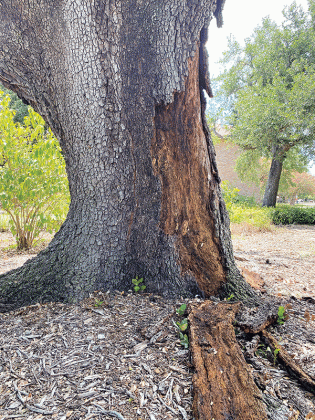
Heather Kirk-Ballard / LSU AgCenter horticulturist
We are well into hurricane season here in Louisiana, but we still have a long time ahead of us. The hurricane season officially begins each summer on June 1 and lasts until Nov. 30. With the increasing frequency and intensity of storms, understanding the risks posed by damaged trees and taking proactive measures can help prevent extensive damage to homes and property.
Now is a great time to inspect your property and trees for potential hazards. Trees are important features of our landscapes and do so much for our environment. However, they can become hazardous during hurricanes.
Strong winds, heavy rainfall and storm surges can weaken the root systems, snap branches and even uproot entire trees, turning them into potential projectiles that threaten lives and property. Consequently, the assessment and maintenance of trees on residential and public properties play a pivotal role in safeguarding homes and communities.
One of the primary reasons for assessing tree damage lies in identifying weakened or compromised trees before a storm hits. Work with certified, licensed arborists and tree care professionals who can provide an expert evaluation of tree health, structural integrity and potential hazards. These professionals possess the knowledge and experience to identify signs of decay, disease and structural defects that may predispose a tree to failure during severe weather conditions.
Additionally, evaluating trees can help determine their proximity to buildings, power lines and other infrastructure, allowing for necessary preventive measures to be taken. Pruning dead or weak branches, thinning dense canopies and even removing hazardous trees altogether can significantly reduce the risk of property damage. Regular inspections and maintenance should be conducted, especially during hurricane season, to promptly address any developing issues.
Homeowners should consider any potential risks associated with trees during hurricanes and seek professional guidance when necessary. By being proactive and responsive, homeowners can take steps to mitigate risks, such as removing weak or diseased trees, pruning branches near structures and securing large trees with professional-grade straps or cables.
Assessing the health of trees on your property and around your home is an important task to perform to ensure their well-being and address any potential issues. Here are some steps you can follow:
1. Visual inspection: Start by visually inspecting the tree. Look for any signs of damage such as broken or hanging branches, cracks in the trunk and holes in the bark. Examine the overall appearance of the tree, including the color and condition of the leaves or needles.
2. Leaf or needle examination: Carefully examine the foliage of the tree. Check for discoloration, wilting and unusual patterns on the leaves or needles. Some common issues include yellowing, browning, spots and chewed edges, which could indicate pest infestation, disease and nutrient deficiencies.
3. Trunk assessment: Inspect the trunk of the tree for any visible signs of decay, wounds and fungal growth. Look for cracks, hollow areas and missing bark. These can be indicators of internal damage or disease.
4. Root inspection: Assess the condition of the tree’s root system. Gently scrape away the soil near the base of the tree to expose the roots. Healthy roots should be firm, white and evenly distributed. Diseased or damaged roots could appear discolored, mushy or have a foul smell.
5. Pest and disease identification: Look for symptoms specific to certain pests or diseases, such as insect activity, webbing and characteristic patterns on leaves. If you suspect a specific issue, you can consult an arborist, your local LSU AgCenter agent or online plant health resources for guidance.
6. Note environmental factors that may affect tree health, such as drought, excessive water, temperature extremes and poor soil conditions. Many of these can stress trees and make them more susceptible to pests and disease.
7. Seek professional help: If you’re unsure about the tree’s health or need assistance, consult with a certified arborist or tree care professional. They have the expertise and experience to accurately assess tree health and provide appropriate recommendations for treatment or care.
If you have any dead trees or large shrubs in the landscape, have them removed by a certified arborist. You can consult the Louisiana Department of Agriculture and Forestry’s website for a list of certified arborists. Arborists that are licensed and insured are a safe bet.
Look for professionals certified by the International Society of Arboriculture and accredited by the American National Standards Institute National Accreditation Board. Additionally, Tree Care Industry Association-accredited companies have an additional layer of consumer confidence verification.
Remember, tree health assessment is an ongoing process, and regular monitoring is important to detect any changes or issues early on.
